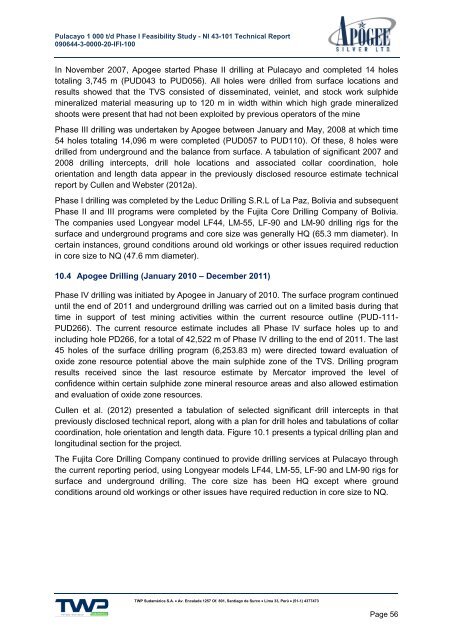Pulacayo Project Feasibility Study - Apogee Silver
Pulacayo Project Feasibility Study - Apogee Silver
Pulacayo Project Feasibility Study - Apogee Silver
You also want an ePaper? Increase the reach of your titles
YUMPU automatically turns print PDFs into web optimized ePapers that Google loves.
<strong>Pulacayo</strong> 1 000 t/d Phase I <strong>Feasibility</strong> <strong>Study</strong> - NI 43-101 Technical Report<br />
090644-3-0000-20-IFI-100<br />
In November 2007, <strong>Apogee</strong> started Phase II drilling at <strong>Pulacayo</strong> and completed 14 holes<br />
totaling 3,745 m (PUD043 to PUD056). All holes were drilled from surface locations and<br />
results showed that the TVS consisted of disseminated, veinlet, and stock work sulphide<br />
mineralized material measuring up to 120 m in width within which high grade mineralized<br />
shoots were present that had not been exploited by previous operators of the mine<br />
Phase III drilling was undertaken by <strong>Apogee</strong> between January and May, 2008 at which time<br />
54 holes totaling 14,096 m were completed (PUD057 to PUD110). Of these, 8 holes were<br />
drilled from underground and the balance from surface. A tabulation of significant 2007 and<br />
2008 drilling intercepts, drill hole locations and associated collar coordination, hole<br />
orientation and length data appear in the previously disclosed resource estimate technical<br />
report by Cullen and Webster (2012a).<br />
Phase I drilling was completed by the Leduc Drilling S.R.L of La Paz, Bolivia and subsequent<br />
Phase II and III programs were completed by the Fujita Core Drilling Company of Bolivia.<br />
The companies used Longyear model LF44, LM-55, LF-90 and LM-90 drilling rigs for the<br />
surface and underground programs and core size was generally HQ (65.3 mm diameter). In<br />
certain instances, ground conditions around old workings or other issues required reduction<br />
in core size to NQ (47.6 mm diameter).<br />
10.4 <strong>Apogee</strong> Drilling (January 2010 – December 2011)<br />
Phase IV drilling was initiated by <strong>Apogee</strong> in January of 2010. The surface program continued<br />
until the end of 2011 and underground drilling was carried out on a limited basis during that<br />
time in support of test mining activities within the current resource outline (PUD-111-<br />
PUD266). The current resource estimate includes all Phase IV surface holes up to and<br />
including hole PD266, for a total of 42,522 m of Phase IV drilling to the end of 2011. The last<br />
45 holes of the surface drilling program (6,253.83 m) were directed toward evaluation of<br />
oxide zone resource potential above the main sulphide zone of the TVS. Drilling program<br />
results received since the last resource estimate by Mercator improved the level of<br />
confidence within certain sulphide zone mineral resource areas and also allowed estimation<br />
and evaluation of oxide zone resources.<br />
Cullen et al. (2012) presented a tabulation of selected significant drill intercepts in that<br />
previously disclosed technical report, along with a plan for drill holes and tabulations of collar<br />
coordination, hole orientation and length data. Figure 10.1 presents a typical drilling plan and<br />
longitudinal section for the project.<br />
The Fujita Core Drilling Company continued to provide drilling services at <strong>Pulacayo</strong> through<br />
the current reporting period, using Longyear models LF44, LM-55, LF-90 and LM-90 rigs for<br />
surface and underground drilling. The core size has been HQ except where ground<br />
conditions around old workings or other issues have required reduction in core size to NQ.<br />
TWP Sudamérica S.A. Av. Encalada 1257 Of. 801, Santiago de Surco Lima 33, Perú (51-1) 4377473<br />
Page 56



